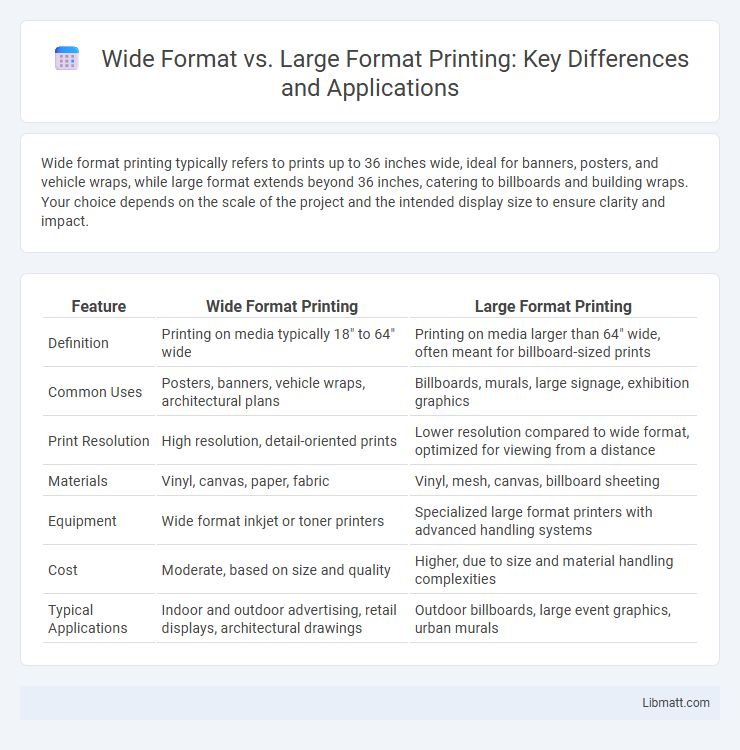Wide format printing typically refers to prints up to 36 inches wide, ideal for banners, posters, and vehicle wraps, while large format extends beyond 36 inches, catering to billboards and building wraps. Your choice depends on the scale of the project and the intended display size to ensure clarity and impact.
Table of Comparison
| Feature | Wide Format Printing | Large Format Printing |
|---|---|---|
| Definition | Printing on media typically 18" to 64" wide | Printing on media larger than 64" wide, often meant for billboard-sized prints |
| Common Uses | Posters, banners, vehicle wraps, architectural plans | Billboards, murals, large signage, exhibition graphics |
| Print Resolution | High resolution, detail-oriented prints | Lower resolution compared to wide format, optimized for viewing from a distance |
| Materials | Vinyl, canvas, paper, fabric | Vinyl, mesh, canvas, billboard sheeting |
| Equipment | Wide format inkjet or toner printers | Specialized large format printers with advanced handling systems |
| Cost | Moderate, based on size and quality | Higher, due to size and material handling complexities |
| Typical Applications | Indoor and outdoor advertising, retail displays, architectural drawings | Outdoor billboards, large event graphics, urban murals |
Introduction: Understanding Wide Format vs Large Format
Wide format printing typically refers to prints ranging from 18 inches to 54 inches in width, ideal for banners, posters, and vehicle graphics. Large format printing generally covers anything above 54 inches, often used for billboards, building wraps, and architectural drawings. Differentiating these formats helps businesses select the right printing technology and materials to maximize visual impact and cost efficiency.
Defining Wide Format Printing
Wide format printing refers to printing media that is typically between 18 and 100 inches wide, used primarily for producing banners, posters, and signage with high-resolution graphics. It involves specialized printers capable of handling wide rolls of paper or other materials, delivering vibrant colors and sharp detail for advertising and promotional purposes. This technology contrasts with large format printing, which generally encompasses sizes beyond 100 inches and caters to larger-scale projects such as billboards and architectural plans.
What Is Large Format Printing?
Large format printing refers to creating prints typically larger than 18 inches wide, designed for banners, posters, and signage that demand high resolution and vibrant color accuracy. Unlike wide format printing, which generally covers widths between 18 and 64 inches focusing on indoor applications, large format printing emphasizes durability and weather resistance for outdoor use. Your projects benefit from large format printing when vibrant, durable graphics are essential for impactful advertising and displays.
Key Differences Between Wide and Large Format
Wide format printing typically refers to print widths between 24 and 60 inches, primarily used for banners, posters, and vehicle wraps. Large format printing exceeds 60 inches and is designed for massive displays such as billboards and architectural drawings. The key differences lie in print size capacity, intended application, and equipment compatibility.
Common Applications for Wide Format
Wide format printing is commonly used for applications such as banners, posters, trade show graphics, vehicle wraps, and architectural blueprints due to its ability to produce high-quality images on materials up to 100 inches wide. Your business can benefit from wide format printers when creating detailed designs that require vibrant colors and precise resolution on flexible media like vinyl, fabric, and paper. This type of printing is ideal for marketing materials and signage that demand both size and visual impact.
Typical Uses for Large Format
Large format printing is commonly used for creating posters, banners, signage, and displays that require high-resolution graphics and vivid colors to capture attention in retail environments, trade shows, and outdoor advertising. This format supports a variety of substrates like vinyl, fabric, and paper, making it versatile for both indoor and outdoor applications. You can leverage large format printing to produce impactful marketing materials and visual communication tools that enhance brand visibility on a grand scale.
Print Quality: Wide vs Large Format
Wide format printers typically offer higher resolution capabilities, achieving detailed print quality ideal for photographic and fine art reproductions. Large format printers prioritize speed and efficiency, often used for banners and posters where vibrant colors and durability outweigh ultra-fine detail. Selecting between wide and large format print quality depends on the balance of resolution needs versus print size and production volume.
Cost Considerations for Each Format
Wide format printing generally costs less per square foot due to lower material usage and faster production times, making it ideal for budget-conscious projects like banners and posters. Large format printing, while offering higher resolution and greater detail suitable for billboards and architectural drawings, incurs higher costs due to specialized substrates and extended drying times. Evaluating print size, material requirements, and project complexity is essential for accurately estimating expenses between wide and large format options.
Choosing the Right Format for Your Needs
Choosing between wide format and large format printing depends on the specific dimensions and resolution required for your project. Wide format typically refers to prints up to 60 inches wide, ideal for banners or posters, while large format extends beyond 60 inches, suitable for billboards and oversized graphics. Assessing the print size, substrate, and intended viewing distance will help determine the best format to meet your needs effectively.
Conclusion: Which Format Suits You Best?
Wide format printing is ideal for projects requiring detailed graphics and smaller scales, such as posters and indoor signage, typically up to 60 inches wide. Large format printing suits expansive applications like billboards, vehicle wraps, and large outdoor banners exceeding 60 inches, offering higher visibility from a distance. Choose wide format for precision and indoor use, while large format meets the needs of impactful, large-scale outdoor advertising and installations.
Wide Format vs Large Format Infographic

 libmatt.com
libmatt.com